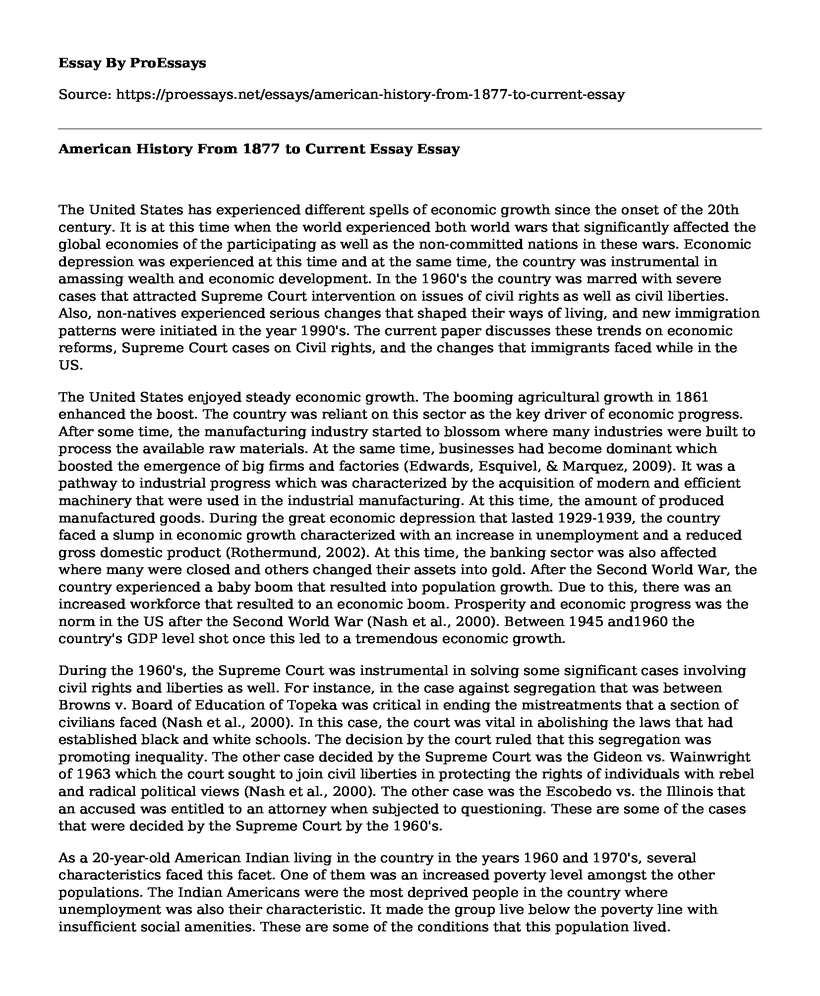The United States has experienced different spells of economic growth since the onset of the 20th century. It is at this time when the world experienced both world wars that significantly affected the global economies of the participating as well as the non-committed nations in these wars. Economic depression was experienced at this time and at the same time, the country was instrumental in amassing wealth and economic development. In the 1960's the country was marred with severe cases that attracted Supreme Court intervention on issues of civil rights as well as civil liberties. Also, non-natives experienced serious changes that shaped their ways of living, and new immigration patterns were initiated in the year 1990's. The current paper discusses these trends on economic reforms, Supreme Court cases on Civil rights, and the changes that immigrants faced while in the US.
The United States enjoyed steady economic growth. The booming agricultural growth in 1861 enhanced the boost. The country was reliant on this sector as the key driver of economic progress. After some time, the manufacturing industry started to blossom where many industries were built to process the available raw materials. At the same time, businesses had become dominant which boosted the emergence of big firms and factories (Edwards, Esquivel, & Marquez, 2009). It was a pathway to industrial progress which was characterized by the acquisition of modern and efficient machinery that were used in the industrial manufacturing. At this time, the amount of produced manufactured goods. During the great economic depression that lasted 1929-1939, the country faced a slump in economic growth characterized with an increase in unemployment and a reduced gross domestic product (Rothermund, 2002). At this time, the banking sector was also affected where many were closed and others changed their assets into gold. After the Second World War, the country experienced a baby boom that resulted into population growth. Due to this, there was an increased workforce that resulted to an economic boom. Prosperity and economic progress was the norm in the US after the Second World War (Nash et al., 2000). Between 1945 and1960 the country's GDP level shot once this led to a tremendous economic growth.
During the 1960's, the Supreme Court was instrumental in solving some significant cases involving civil rights and liberties as well. For instance, in the case against segregation that was between Browns v. Board of Education of Topeka was critical in ending the mistreatments that a section of civilians faced (Nash et al., 2000). In this case, the court was vital in abolishing the laws that had established black and white schools. The decision by the court ruled that this segregation was promoting inequality. The other case decided by the Supreme Court was the Gideon vs. Wainwright of 1963 which the court sought to join civil liberties in protecting the rights of individuals with rebel and radical political views (Nash et al., 2000). The other case was the Escobedo vs. the Illinois that an accused was entitled to an attorney when subjected to questioning. These are some of the cases that were decided by the Supreme Court by the 1960's.
As a 20-year-old American Indian living in the country in the years 1960 and 1970's, several characteristics faced this facet. One of them was an increased poverty level amongst the other populations. The Indian Americans were the most deprived people in the country where unemployment was also their characteristic. It made the group live below the poverty line with insufficient social amenities. These are some of the conditions that this population lived.
Conclusion
The US faced a wave of immigrants into the country in the 1990's which altered the settlement patterns in the country. The new immigrants at this time changed the past trend where they settled in the Contiguous States (In Massey, 2008). In the 1990's, the immigrants altered the pattern and ended around the Western States with a few concentrated around the North East. As a consequence, the US reacted by passing laws that hindered illegal immigration. For instance, illegal immigrants were barred from accessing food stamps as well as disability assistance from the US government (Nash et al., 2000). The Congress took the move in a bid to reduce illegal entry into the country.
References
Edwards, S., Esquivel, G., & Marquez, G. (2009). The Decline of Latin American Economies: Growth, Institutions, and Crises. Chicago, IL University of Chicago Press 2009.
In Massey, D. S. (2008). New faces in new places: The changing geography of American immigration. New York: Russell Sage Foundation.
Nash, G. B., Jeffrey, J. R., Howe, J. R., Davis, A. F., Frederick, P. J., & Winkler, A. M. (Eds.). (2000). The American people: Creating a nation and a society (Vol. 2). Addison-Wesley.
Rothermund, D. (2002). The global impact of the Great Depression 1929-1939. Routledge.
Cite this page
American History From 1877 to Current Essay. (2022, Sep 26). Retrieved from https://proessays.net/essays/american-history-from-1877-to-current-essay
If you are the original author of this essay and no longer wish to have it published on the ProEssays website, please click below to request its removal:
- Meaning of the Term "Roman Imperialism" Essay
- Essay Sample on Effects of Non-Prescribed Stimulants Among Students and Young Adults
- Research Paper on Domestic Violence: A Household Pandemic That Should Never Happen
- Essay Example on Organ Trafficking in Egypt: They Locked Me In and Took My Kidney
- Essay Sample on Immigration Limits: Unjustified Racism or Necessary Policy?
- Black Juveniles of Color: Unwinnable Plights of Sex-Trafficked Kids - Essay Sample
- Transformative Forces in American History: Commerce, Politics, and Slavery from Colonies to Jacksonian Era







